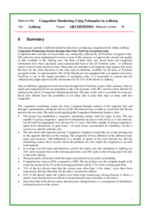Congestion monitoring using telematics
Summary
Traffic in Aalborg is concentrated around peak times, which causes congestion and leads to high levels of energy consumption. The city is testing whether providing information to drivers can influence their choice of route and travel time.
Implementing sustainable mobility
About 20 percent of all traffic in Aalborg occurs within two hours of the day in the morning and afternoon. Monitoring congestion will enable the city to provide drivers with actual information on travel time savings if they re-schedule their journey outside of peak times. Less congestion will also create better conditions for public transport.
The main objectives of the measure are to:
- Reduce congestion during rush hour and optimise traffic flow;
- Reduce energy consumption; and
- Make public transport more attractive.
Progress
This measure includes 2 different initiatives that focus at reducing congestion levels within Aalborg:
1.Congestion Monitoring System through data from TomTom navigation units
Congestion data and data on travel times are continually collected by all TomTom navigation units. 100 units have been implemented in taxies to improve the amount and quality of data available in the Aalborg area. On basis of these data collection, new travel times and congestion information have been calculated, and communicated back to the all TomTom units – to influence choice of travel route and travel time. These data are included in all regularly map updates that forms the base for the route directions in the units and are therefore available for all users of TomTom navigation units. As approximately 48% of the Danish cars are equipped with a navigation unit, being TomTom one of the largest providers, it is reasonable to assume that the collected data might improve traffic information for 10-15% of the drivers in Aalborg.
Data on different aggregation levels have been bought from TomTom. Data on speed and congestion levels are presented on the web accessible for everyone. Road users thereby have the possibility to use these data to plan their trips on times with less congestion.
2.Adaptive Traffic Signal Control System (SPOT system)
Furthermore, this measure has introduced an advanced signal control system optimizing the traffic flow from a network approach. The Adaptive Traffic Signal Control System was planned and implemented on the most congested part of the main ring road, Østre Alle, outside the centre of Aalborg. Furthermore, the system in Aalborg allows central monitoring and gives expanded possibilities for operating the traffic signals.
Outcomes
1.Congestion Monitoring System through data from TomTom navigation units
The congestion monitoring system has been evaluated through analysis of the acquired data and through a survey for 100 selected taxis in order to reveal how the drivers perceive the new data. The main result regarding the Congestion Monitoring System is that:
- The project has established a congestion monitoring system, with two types of data. The one able of giving congestion / speed level information on day-of-week level, in 5’intervals, for all roads aggregated over all days for 2-3 years. The other capable of giving congestion / speed level information on peak / off peak hours, accumulated for weekdays, for the 4 seasons in a year.
- As expected, congestion is highest towards the city in the morning and in the opposite direction in the evening. The congestion level is different on the different road- types and locations, with bottlenecks in a number of places in the road network. But the monitoring system shows exactly where the problems are, how much the congestion is on each road segment.
- In average over all routes and for the whole year, Aalborg commuters use 34% more transport time in the mornrning peak hour, and 30% more in the evening peak hour.
- The peak traffic affects the whole the major road network in its traffic-accessibility.
- Congestion has risen in 2010, compared to 2009. The travel time over the complete length of all routes has increased by 2% in the morning peak hours and by 3.3% in the evening peak hour.
- 74% of the taxi drivers state that the system quite often saves them from unnecessary driving when they are driving to an unknown address. 43% of the drivers states the system saves them from unnecessary driving because it shows a shorter route than the previously chosen.,
- More than half of the drivers states, that they have changed route as a consequence of disturbance information given in the system.
2.Adaptive Traffic Signal Control System (SPOT system)
The main results regarding the Adaptive Traffic Signal Control System were:
- Transportation time decreased in average with 25’’ (8.5%) per trip in the peak periods. It is mainly due to a significant effect in the most congested period of the day, the afternoon peak. No positive effects were found regarding the off-peak results.
- When the variation in traffic flows is taken into account, the total reduction in transportation time per year equals to 35,500 hours per year on the section of the ring road.
- The change in speed results in most cases in increase of the low speeds, i.e. fewer and shorter decelerations in front of the intersections.
- Due to smoother driving pattern has the estimated fuel consumption decreased with 2.45%, or equal to a 33,000 litres reduction per year on the section of the ring road.









